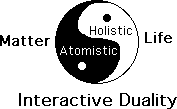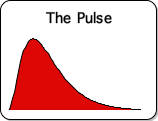Table of Contents
1. The Pulse & Sustained Attention Experiences (Aug 10, 2018 - June 21, 2019)
2. Attention & Matter: Interacting Realms of Existence? (Aug ?, 2018)
3. Galileo: Victim of Academia & Hubris? (Jan 14, 2019)
4. Galileo: Secular Saint of Freemasonry? (Feb 4, 2019)
5. Galileo's Relics & the Collective Life Force? (Feb 22, 2019)
6. Ptolemy: Paradigms of Science (Apr 6, 2019)
7. Our Intimate Solar System (Apr 14, 2019)
8. Ptolemy: Monotheism & our Paradoxical Polyverse (May 19, 2019)
9. Lucretius: Atomism, the Swerve & Holism (May 31, 2019)
10. Tweet #1 (February 21, 2020)
The Pulse & Sustained Attention Experiences
Greetings friends,
What are the factors that provide us with our most pleasurable experiences?
According to my findings, we are happiest when engaged in Sustained Attention Experiences (SAEs). This type of experience rises to a peak and then reaches a natural culmination. SAEs permeate human existence, e.g. conversations, reading, entertainment events, sports and creative sessions. Dr. Csikszentmihalyi’s research exhibited that a special kind of SAE, the Flow Experience, provides us with our best experiences.
What factors inhibits our ability to have these SAEs?
Both interruptions and an inflated sense of self (ego) tend to deflate or kill these optimal experiences.
The Pulse, a mathematical feature of Data Stream Dynamics, effectively models Sustained Attention Experiences. This congruence of empirical data and mathematics both validates and lends further credence to my Theory of Attention.
For a more complete development of these ideas, check out the article The Pulse & Sustained Attention Experiences.
Let me know what you think. Comments, questions, suggestions, and critiques are always encouraged and welcome.
Regards, the collection of neural networks commonly known as don
P.S. Please notify me if you don't want to receive these transmissions.
Attention & Matter: Interacting Realms of Existence?
Greetings,
Have you ever felt that our modern world is too materialistic? Could this mindset be due, at least in part, to the excessive material orientation of the scientific community? Is it possible that Life's mystery has been undervalued in the quest for certainty? If you sense that Science is neglecting a feature that makes Life special, you might be interested in my latest article - Attention & Matter: Interacting Realms of Existence?
It seems fairly evident that living systems have a feature that exclusively material systems do not have – Attention. Could Attention be subject to a different set of mathematical laws than the world of Matter? According to my Theory of Attention, the answer is an unequivocal Yes! Indeed, the mathematical laws of the Realm of Attention provide the rationale for many features of living behavior that are unaccounted for by the laws of Matter.
Further, this mathematical system – Data Stream Dynamics – reveals that the underlying structure of reality in the Realm of Attention is entirely different from reality in our everyday Atomic Realm, which is entirely different from reality in the enigmatic Subatomic Realm. Due in part to these extreme differences, we suggest that the Universe consists of 3 interacting realms of existence – Atomic, Subatomic and Attention, rather than a single Material Realm.
3 Different Mathematical Systems -> 3 Realities -> 3 Interacting Realms
Ultimately, we suggest that the interaction of the Subatomic and Atomic Realms generates the Material Realm and that the interaction between the Material and Attention Realms generates the Living Realm.


Let me know what you think. Comments, questions, suggestions, and critiques are always encouraged and welcome.
Regards, the collection of neural networks commonly known as don
P.S. Please notify me if you don't want to receive these transmissions.
Galileo: Victim of Academia & Hubris
Greetings friends,
As a super-social species, humans require interaction, which includes sharing. In light of this hard-wired tendency, I would like to share one of my recently posted articles with you.
Strangely enough, it regards Galileo, the first modern scientist. As many of you know, the Inquisition convicted him of heresy, presumably due to his support for Copernicus' heliocentric solar system. The traditional narrative inspires the Reader to align with true Science against false Religion. This attitude irritates me, especially because the true villain has distorted Galileo's story to hide their involvement – accusing someone else of the crime when they are the culprit. Rather than Religion, Galileo's primary and initial conflict was with a dogmatic Academia.
For more check out Galileo: Victim of Academia & Hubris. See how the Catholic Church was a latecomer to the Copernican controversy. Find out how Galileo's arrogant sarcasm catalyzed the Papacy's stand against Copernicanism. Discover why the Church's punishment turned out to be a creative blessing for Galileo.
Why is this historical example significant to me? This distortion of the facts to discredit religion is yet another example of how the cult of scientism has inflitrated the belief system of the educated. Although derived from science, scientism is faith-based like any other religion. One of scientism's primary beliefs is that all phenomena have a material explantion. In contrast, the research that resulted in my Theory of Attention indicates that Life has a non-material component that includes intention, mental energy and choice. By exposing scientism to daylight, I am hoping that some opened Minds might entertain my theory.
Let me know what you think. Comments, questions, suggestions, and critiques are always encouraged and welcome.
Regards, the madman commonly known as don
P.S. Please notify me if you don't want to receive these transmissions.
Galileo: Saint of Freemasonry
Greetings friends,
Proudly presenting Galileo: Saint of Freemasonry?, one of a series of historical articles from my Scientific Manifesto. The story pertains to the positive relationship between Galileo and Freemasonry, not during his lifetime, but postmortem.
The controversy surrounding Galileo, i.e. his conviction for heresy for advocating a sun-centered universe, did not end with his death in 1642. A century later, Catholic Freemasons unearthed his skeleton, extracted some bones, and then reburied his remains in the cemetery of a Catholic Church in Florence. This bizarre Masonic ritual was the equivalent of bestowing secular sainthood upon Galileo. A 21st century museum of science in Florence named after Galileo proudly displays his relics.
This factoid evokes some intriguing questions. If two Popes banned Freemasonry, how could someone be both a Catholic and a Freemason? It seems like a contradiction in terms. Many consider Galileo to be the first modern scientist. Most scientists don’t believe in saints. The Freemasons don’t believe in saints. Why would Catholic Freemasons perform a ritual that confers sainthood on Galileo, the ultimate scientist?
To answer these questions, read Galileo: Saint of Freemasonry. Discover how Freemasonry evolved from a local guild to an international organization. See why this organization was appealing to both scientists and businessmen. Learn how the Lodges were tolerant religiously and theist. Find out how this secretive fraternal society was instrumental in overthrowing the Old Order, i.e. the power, authority and privileges of Royal Blood and the Church. Learn how Freemasonry created a place for Business in the power structure. Understand how Democracy fits into Freemasonry’s New World Order. Finally discover how Galileo’s remains stand as a testament to the complementary nature of Science and Religion.
Why is this information significant to me? The article illustrates that in centuries past, the powerful and the educated, including scientists, respected and supported both scientific endeavors and religious beliefs. For the great thinkers of this era, there was no animosity between the two perspectives. These kindred spirits from past times provide silent support for the notion that our living Universe consists of more than a single, deterministic Material Realm and instead includes multiple realms of existence, one of which entails the ability to choose. This belief is in accord with the underlying tenets of my Theory of Attention.
Thanks for any time that you invest in my project. Let me know what you think. Comments, questions, suggestions, and critiques are always encouraged and welcome.
Regards, the collection of neural networks commonly known as don
P.S. Please notify me if you don't want to receive these transmissions.
Galileo’s Relics & the Life Force?
Happy Full Moon plus a few,
Proudly presenting Galileo’s Relics & the Collective Life Force? – an article from my Scientific Manifesto.
Eighteen century Italian Freemasons extracted bones from Galileo’s skeleton to indicate that they considered him to be a ‘secular saint’. Florence's museum of science proudly displays these relics, e.g. Galileo’s finger bones.
Read Galileo’s Relics to find out why the widespread veneration of relics and relic-like objects such as Galileo’s bones implies the existence of a collective life force. Discover why the existence of a life force implies the existence of intention, attention and mental energy. See how the Material Paradigm, i.e. all phenomena have a material explanation, is helpless before the life force as well as our intentional urge to organize our environment. Find out why this impotence before these widespread phenomena indicates the need for a new scientific paradigm – a fresh Math/Data Matrix that expands the dialogue to include Attention and mental energy. Finally discover how Lehman’s Theory of Attention fulfills these requirements.
(Note: Blue indicates articles; Green indicates glossary items.)
Thanks for investing your precious Attention in my project. Let me know what you think. Comments, questions, suggestions, and critiques are always encouraged and welcome.
Regards, the evolving set of nemes, i.e. neural meta-structures, that constitute don
P.S. Please notify me if you don't want to receive these transmissions.
6. Ptolemy: Basic Paradigms of Science
Happy New Moon,
Nature has some wondrous features that continue to fill me with awe. 1) The natural order can be understood through human reason. 2) Mathematics is a symbolic language of this order. 3) Elegant simplicity is a significant component of natural law. As these fundamental beliefs also drive the scientific endeavor - I call them the basic paradigms of science.
Where did these notions originate? This article suggests that the answer to all three questions is the same – Ptolemy’s mathematical system for predicting planetary position – developed nearly 2000 years ago. Read Ptolemy: Basic Paradigms of Science to find out how astrological considerations drove Ptolemy to develop a mathematical technique for predicting planetary position. Discover how the predictive power of Ptolemy’s Math/Astronomy matrix provided a subliminal message that transformed Western civilization.
Why am I impelled to write an alternate history regarding the founders of science – Galileo, Copernicus, Kepler and now Ptolemy? Presumably to provide a historical context for my Theory of Attention. Where does it fit in the grand scheme of things?
In parallel fashion to both the Ptolemaic system and the Material Realm, the Living Realm of Attention has a mathematical component that embodies elegant simplicity. Just as the Ptolemaic system expanded our horizons, it is hoped that my Math/Attention matrix will transform our understanding of the Present. Rather than an instantaneous event, my model suggests that Attention must be sustained for a sufficient duration to have a transformative Experience.
(Note: Blue indicates articles; Green indicates glossary items.)
Thanks for any Attention devoted to my project. Let me know what you think. Comments, questions, suggestions, and critiques are always encouraged and welcome.
Regards, the collection of neural networks commonly known as don
P.S. Please notify me if you don't want to receive these transmissions.
7. Our Intimate Solar System
Salutations,
Most of us find the natural order to be beautiful. For instance, it is thrilling to see the seemingly organized riot of colors from the abundance of wild flowers that currently grace our landscape or an oak tree’s intricate leaf structure. While sometimes visible to the naked eye, science frequently employs mathematics to reveal the elegant simplicity that is at the heart of Nature. I would like to share an example of this kind that renders our own solar system a bit more intimate.
A casual glance at the nighttime sky reveals a chaotic assemblage of uncountable starry pinpoints. Although there is no visual order to the heavenly firmament, most of us are aware that we inhabit a solar system consisting of 9 planets that revolve about the Sun. While these huge masses seem to operate independently of each other, mathematics reveals a simple natural order that connects us as an inter-connected group of planetary neighbors.
The attached graph illustrates how the distance between planetary orbits is equal when viewed from the proper perspective, i.e. double logarithmic. The orderly step-like progression of planetary distances is simply gorgeous, at least to my eyes. The intimacy of the relationships evokes the image of a solar community rather than impersonal, disconnected parts.
Experience the natural beautiful order of our own solar system as revealed by mathematics. (For a more in depth analysis, check out: Harmony of the Planets.)
Best to all, the don collection
P.S. Please notify me if you don't want to receive these transmissions.
8. Ptolemaic System: Monotheism & our Paradoxical Poly-verse
Greetings all,
Embracing paradox, the monistic one-truth attitude has always aggravated me. Am excited to have finally formulated a theoretical stance that justifies my position.
Starts with how Ptolemy’s astronomical system could easily have contributed to the rise of the beliefs in both monotheism and eventually scientific determinism. Follows with evidence that undermines the one-truth position. Finishes with how absolute truth can fit into a paradoxical whole.
Questions?
Why did monotheism replace polytheism? What role did the Ptolemaic astronomical system play in this cultural transformation? How did the belief in a single God morph into scientific monism – the notion that we inhabit a rational, deterministic Universe composed exclusively of Matter? Why is it probable that we instead inhabit a paradoxical Poly-verse consisting of the interaction between multiple logically consistent Universes – one of which is the Living Realm of Attention? How is the Poly-verse able to encompass contradictory truths?
Paradoxical Poly-verse = Interaction between Logical Universes
Poly-verse = Subatomic x Atomic x Attention
For some plausible answers to these questions, read my latest article – Ptolemy: Monotheism & our Paradoxical Poly-verse.
Best to all, the neural meta-structure frequently referred to as don
P.S. Please notify me if you don't want to receive these transmissions.
9. Lucretius: Atomism, the Swerve & Holism
Salutations,
I am thrilled to share this article, as it draws a sharp line between Matter’s atomistic systems and Life’s holistic systems. It begins with the origin of the philosophy of atomism in the Greco-Roman era. Suppressed by the Christian Church, it reemerged during the Renaissance with the discovery of On the Nature of Things, a poem by Lucretius. This reductionist philosophy holds that the Universe is composed of tiny particles, deemed atoms, and that the deterministic laws governing these nearly invisible parts also govern the whole, including human behavior. The book’s circulation launched all kinds of radical intellectual inquiry that eventually spawned our modern mentality. This novel way of thinking could easily have inspired both Galileo and Newton and eventually led to the discovery of atoms, hence their name.
While the atomistic method has yielded fabulous successes regarding material behavior, atomism has been an abysmal failure regarding living behavior. Why? Could it be our capacity for choice? Even the atomist Lucretius perceived our omni-present capacity for decision-making. To resolve the dilemma, he proposed the Swerve, the notion that we can subtly shape the mechanistic behavior of the material world with our decisions.
We suggest that living systems, rather than atomistic, are instead holistic. Holistic systems are based in contextual relationships rather than absolute content. We further maintain that our world consists of the interaction between Matter’s atomistic systems and Life’s holistic systems - an Interactive Duality. This construct is signficant for me as my Theory of Attention reveals some of the laws that govern the holistic Living Realm.

For a more in depth discussion of these topics, read my most recent article: Lucretius: Atomism, the Swerve & Holism.
Let me know what you think. Comments, questions, suggestions, and critiques are always encouraged and welcome.
Best to all, the don creature
P.S. Please notify me if you don't want to receive these transmissions.
Tweet #1
According to the LA model, #Consciousness employs an image overlay process to generate meaning. Living matter's overlay 'exponent' > 1, while inanimate matter's 'exponent' = 1 (no overlay). This continuum supports #panpsychism.
Floral Jewels 2019 June
Floral Jewels in Pasadena June 7, 8, & 9!
Greetings friends!
I am very happy to announce that the Contemporary Crafts Market's June show is back! As usual, the show will be at the Pasadena Convention Center. The show is this weekend: June 7th - 8th and 9th. The hours are 10 to 6, Friday and Saturday, and 10 to 5 on Sunday. I will be in space #320 and look forward to seeing you.
If you have not received a postcard to get in free, you may print one from the show website at craft source.org.
See you there!
All the best and happy Summer,
Laurie

If you do not wish to receive these notes, please reply 'remove'.
Quotation from Hickok's paper:
“Recent demonstrations of the tendency (a) for neural oscillations to entrain to rhythmic features of stimuli, (b) for intrinsic neural oscillation and stimulus phase to modulate attention and perception, and (c) for attention to be allocated in oscillatory pulses is consistent with an exceptionally broad neural mechanism for rhythmic entrainment that forms the foundation of sensation across species.”
